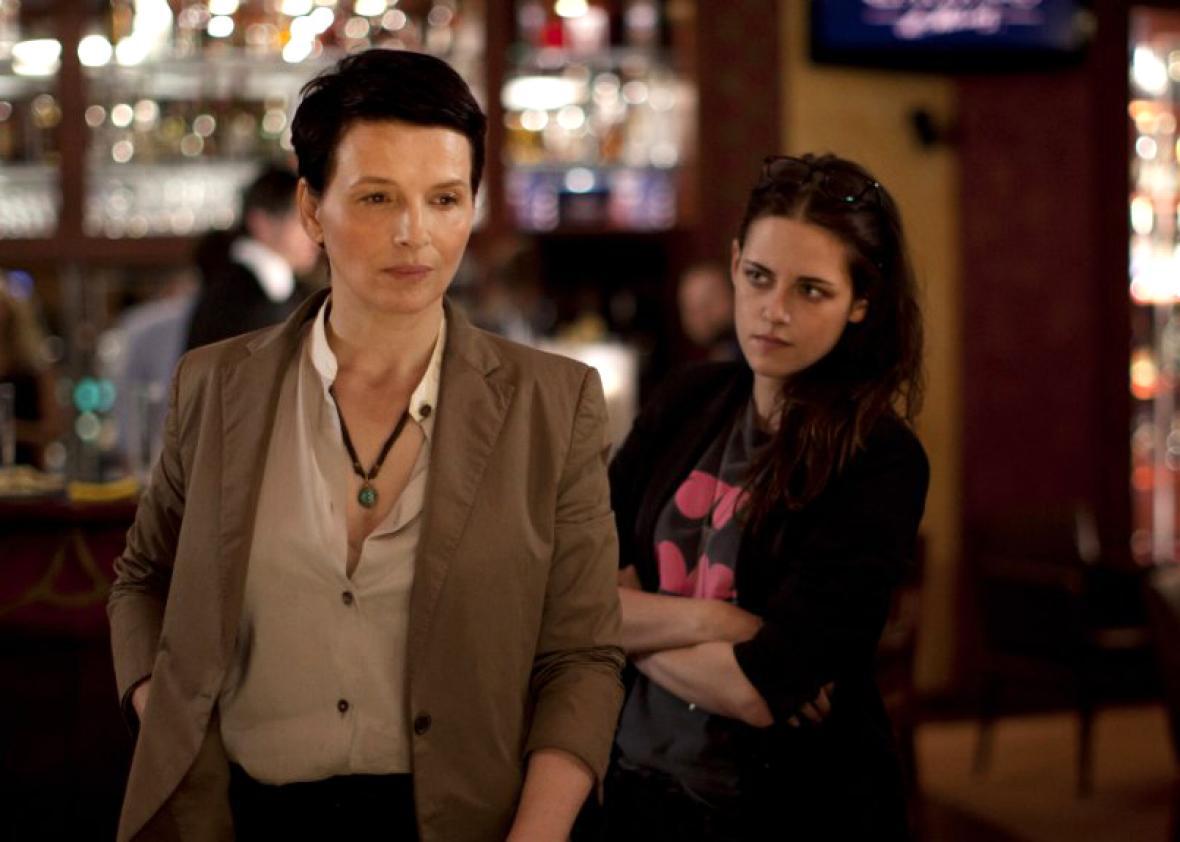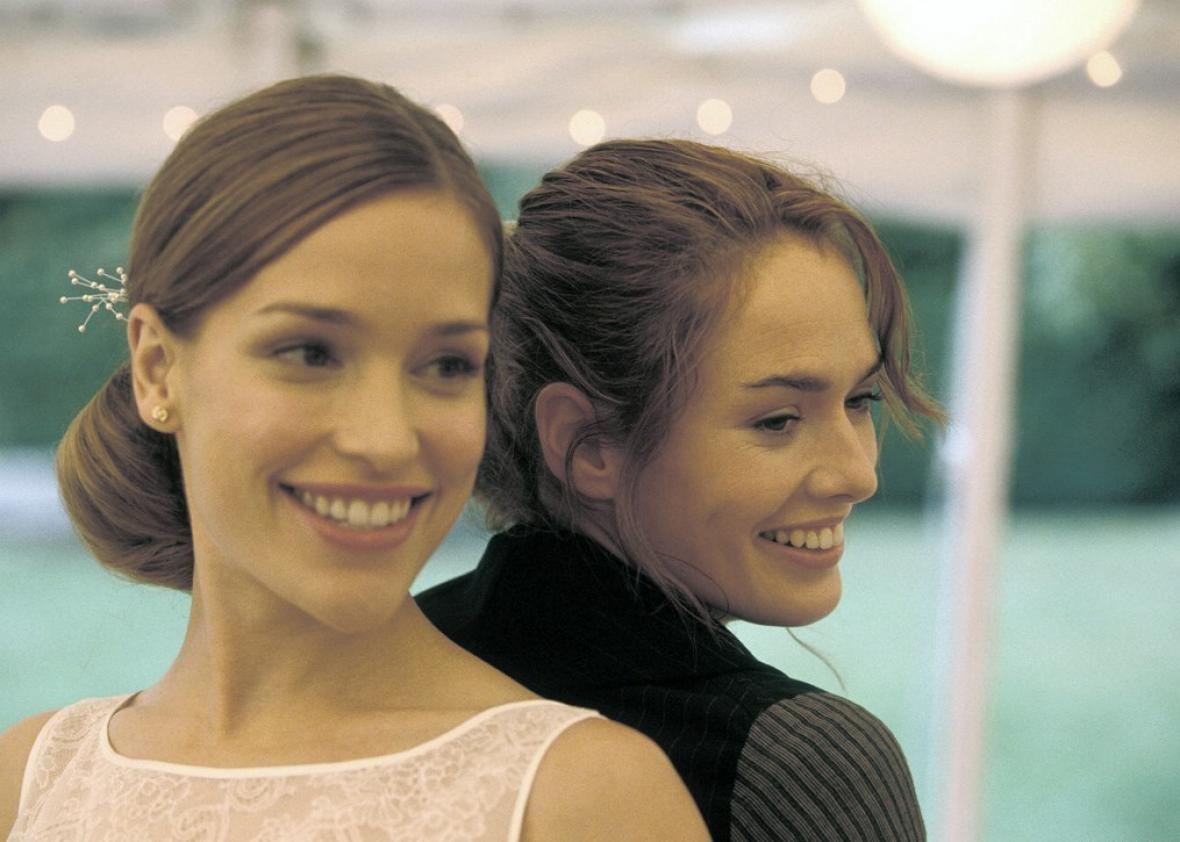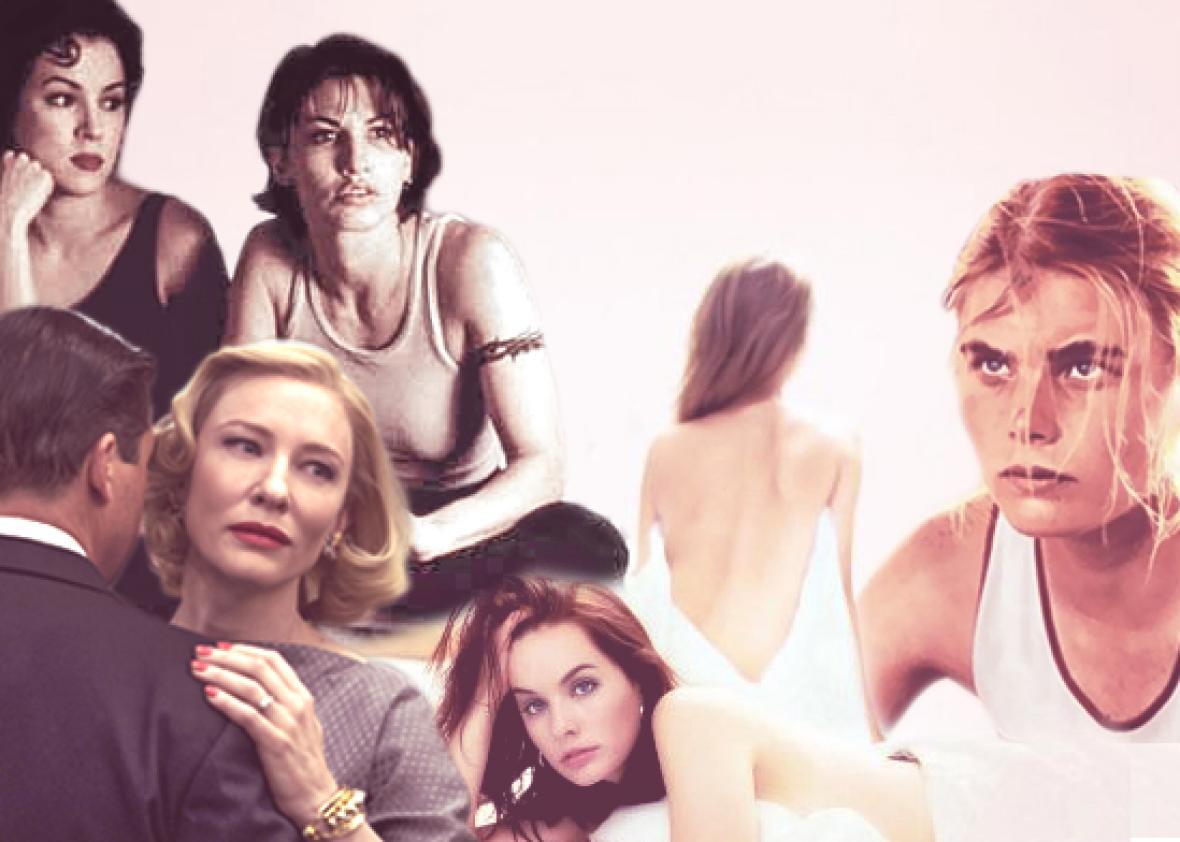A group of young people sits in a claustrophobic women’s studies class circa 1994. The professor approaches the board, chalk in hand, and says, “Let’s make a list of women that you think are lesbians or that you know are lesbians from history or present time.” Replies are slow at first. “Eve,” someone says, half-joking. Someone else suggests Sappho, the Greek poet born in Lesbos; Hannah Höch, a German collage artist; Lily Tomlin, the actress and comedian. Answers begin to flow more quickly: Angela Davis, Mary Lou Retton, Virginia Woolf, Dennis the Menace’s next-door neighbor Margaret, Marilyn Quayle, Olivia Newton John, Peppermint Patty.
One student interrupts the tide with a question. “Why are we even making this list? I mean it’s completely speculation.”
“Well that’s a really good question,” the professor replies. “Throughout lesbian history, there has been a serious lack of evidence to tell us what these women’s lives were truly about. Lesbian lives and lesbian relationships barely exist on paper, and it’s with that in mind and understanding the meaning and the power of history that we begin to want to change history.”
This is the opening scene of Go Fish, a movie released in 1994 about Max, a young lesbian whose friends set her up with Ely, who isn’t her usual type. Although their relationship has a bumpy start, the two women eventually fall in love and find the happily-ever-after ending characteristic of romantic comedies. But this opening scene makes a larger point that Max emphasizes by writing in her journal: In the cultural historical record, lesbianism is largely glossed over, and when it does appear, as in the case of Sappho or Hannah Höch, it’s shadowy and undefined.
Lesbian film follows a similar pattern. The last two years have delivered at least three lesbian love stories starring A- and B-list actresses: Clouds of Sils Maria (2014) with Kristen Stewart, Jenny’s Wedding (2015) with Katherine Heigl and Alexis Bledel, and Freeheld (2015) with Ellen Page and Julianne Moore. Now comes Carol, a love story starring Cate Blanchett and Rooney Mara, which is already generating Oscar buzz.

Photo courtesy Sundance Select
Carol represents a change for the lesbian romance genre. Produced by the Weinstein Co. (responsible for such hits as Django Unchained, The King’s Speech, and Silver Linings Playbook) with a budget of $11.8 million, the film is a far cry even from Clouds of Sils Maria, which was made for $6.6 million, or Freeheld, which cost $7 million, and light-years from Go Fish, which cost roughly $15,000 to make (adjusted for inflation, that’s about $24,000 today). The budgetary increase—as well as the shift from indie production and distribution companies to mainstream ones—represents the shift in Hollywood’s attitude toward lesbian romance movies.
When movies began to take off in the 1920s, there was widespread concern about the moral messages they might spread. “When it became clear that mass audiences were going to show up to see movies, there was a lot of confusion about the impact of the visual image and what people would actually do in real life,” Jack Halberstam, a professor of English and feminist research at the University of Southern California, told me. In other words the authorities were concerned that audiences would imitate what they saw on screen. And so the Motion Picture Code, which provided a list of guidelines as to what could be shown and what couldn’t, was implemented in 1930.
The code outlawed depictions of nudity, white slavery, suggestive dancing, and crime, but it also contained a passage pertinent to homosexuality:
In the case of impure love, the love which society has always regarded as wrong and which has been banned by divine law, the following are important: Impure love must not be presented as attractive and beautiful. It must not be presented in such a way to arouse passion or morbid curiosity on the part of the audience. It must not be made to seem right and permissible.
From 1930 until 1934 studios pretty much ignored the code because the Production Code Administration (also called the Hays Office after Postmaster General William H. Hays) had no power to enforce it—this is known as the “pre-code” era. But in 1934, the Motion Picture Association of America refused to produce, distribute, or exhibit films that didn’t meet the code’s requirements, thereby turning the code’s guidelines into hard-and-fast rules.
In part because of the code and in part due to centuries of ingrained homophobia, depictions of lesbianism in American film became shadowy and suggestive rather than overt. “You had to represent lesbianism as full of horror and abjection in order to pass the code, so everything is implied,” Halberstam said. “Maybe somebody doesn’t have a boyfriend at an older age or somebody is living alone with a much younger woman, but you never can depict lesbianism as such.” Halberstam calls this the “negative image” era of lesbianism in film.
Of course, even if the code hadn’t existed, depictions of lesbians in the ’30s, ’40s, and ’50s wouldn’t necessarily have been positive. These were the years during which Dwight D. Eisenhower, then a military general, ordered the “ferreting out” of lesbians in the army; the years in which homosexuals were “cured” with ice pick lobotomies, shock treatments, and chemical castration; the years in which Alan Turing, a British war hero, was arrested for homosexual activities; the years in which Diana: A Strange Autobiography was published with the footnote: “This is the autobiography of a woman who tried to be normal.”
Despite obstacles, implied lesbians sidled into movies in this era. Mrs. Danvers in 1940’s Rebecca is presumed to be a lesbian (albeit a creepy one); Julie Harris played an implied butch lesbian character in 1952’s The Member of the Wedding, and Mercedes McCambridge frequently played butch characters in films such as Johnny Guitar (1954) and A Touch of Evil (1958). The Killing of Sister George (1968—the year the code was lifted) shows an undisguised lesbian couple, although their romance doesn’t end well.
“The moral of all lesbian stories for basically the entirety of lesbian cinema is that there’s a punishment for being gay,” says Heather Hogan, a senior editor for lesbian culture site Autostraddle.com. “And whether that punishment comes in the form of losing your job or going to prison or being killed, the idea that it perpetuates is that there’s no way for a lesbian to be happy the way straight people are happy.”
In 1959, Some Like It Hot foretold the Hays Code’s demise with its male characters’ cross-dressing, gambling, and booze swigging, but films depicting lesbian romance remained relatively controversial. Allan Moyle’s 1980 film Times Square, which tells the story of two teenage girls who run away to New York City, was originally a lesbian romance. In the original script the two main characters, Nicky and Pammy, fall in love, but producer Robert Stigwood cut much of the romantic subplot from the film, which Moyle says compromised its integrity. Times Square ultimately disappeared into the black hole of irrelevance that swallowed many queer films at the time.
Post-Times Square, the early ’80s were a turning point for lesbian romances—movies of this period depicted explicit lesbian relationships unlike any that had appeared in the American cinema thus far. Personal Best, which was released in 1982, starred Mariel Hemingway as Chris Cahill, an Olympic athlete who falls in love with Tory Skinner (Patrice Donnelly), one of her teammates. Chris and Tory have a flirty relationship and are shown in bed together early on, but the film didn’t take off. The Hunger and Lianna both hit theaters in 1983, and even though one is a cult film about vampires and the other is the story of a woman who leaves her husband when she realizes she’s a lesbian, both also show then-unprecedented intimacy between women on screen.
But just because the number of lesbian romances multiplied in the 1980s doesn’t mean the movies were overwhelmingly positive. Chris and Tory split up in Personal Best, The Hunger exemplifies the trope of one woman preying on another (quite literally) to corrupt her, and in Lianna, the titular character’s lover, Ruth, tries to talk her out of leaving her husband and eventually abandons her. “The intense homophobia of previous generations is a huge influence on all lesbian desire movies ending badly,” filmmaker Jamie Babbit told me. “I think it’s a holdover from years of self-hatred.”
The ’80s also brought us Desert Hearts (1985), which doesn’t succumb to an unhappy ending. Instead it’s ambiguous—lovers Vivian Bell and Cay Rivvers board a train together and ride off into an uncertain (and potentially joyful) future. Desert Hearts was immensely popular with lesbian audiences, but it didn’t earn cult classic status until years after it was released—and the title still draws more recognition in queer circles than it does in straight ones. Although these movies still contain some hallmarks of homophobia, they collectively represent a shift in the culture: That it was OK to show two women falling in love with each other onscreen, and that people would pay to watch them do it.
In the 1990s, most lesbian romance movies fell into one of two categories. The first category is best illustrated by Nicole Conn’s films, which borrow from the romance novel genre. Her first film was 1992’s Claire of the Moon, which showed a presumably straight woman gradually falling for her dark-haired lesbian friend. Cynara: Poetry in Motion, a short film released in 1996, followed from Conn in a similar vein, and one of Lisa Cholodenko’s first films, High Art (1998), also riffed on romance tropes.
Other lesbian romance films of the ’90s embraced the political nature of lesbian relationships and examined their position within the culture. Go Fish in particular was one of the first films to combine queer theory and riot grrrl feminism with a romantic love story, Babbit said. It also avoided the tragedy of its predecessors, leaning instead toward comedy and whimsy. Even serious topics are tempered with joy: When one character is kicked out of her house because her mother discovers she’s gay, she moves in with her girlfriend, cementing their relationship. The supporting characters are silly and conniving and clearly having fun as they try to cajole two of their friends into dating. In many ways, Go Fish is revolutionary because it’s so damn cute.

Photo courtesy Can I Watch/The Samuel Goldwyn Company
It also represents butch-femme relationships—something films before it had rarely done—and movies like Bound (1996) and But I’m a Cheerleader (1999) followed suit. These movies also depicted lesbian sex in new ways; whereas most films followed Desert Hearts’ tradition of suggesting sex by showing one woman’s head moving down another’s body, in Bound, “the sex is really focused on hands and on the penetration of the hand into the body,” said Halberstam. “It was a much more compelling sex scene.”
Unlike Go Fish, 1999’s Boys Don’t Cry, which is based on a true story about the murder of a trans character, is both widely recognized and critically acclaimed. Although its tragic ending echoes those of past decades, Boys Don’t Cry still represents a shift in how queer movies were viewed. “It was one of the first queer films to win an Academy Award, so it legitimized no-budget filmmaking,” Babbit said. “It made filmmakers realize that you could reach a really broad audience.” It also proved that straight actresses could play queer roles, win awards for them, and go on to have varied and lucrative careers.
But I’m a Cheerleader, which Babbit wrote and directed, made waves for many of the same reasons as Go Fish. Its main character, Megan (Natasha Lyonne), is a high-school girl living a perfect life—until her parents send her to a gay rehab camp. Instead of “curing” her, the camp does the opposite: Megan comes out, falls in love with fellow student Graham (Clea DuVall), and ditches her homophobic high-school friends. It’s satire, comedy, and romance all rolled into one, and there was little precedent for it. “I was a young lesbian who wanted to see exactly the movie that I made,” Babbit said. “Studios don’t care that there are young lesbians who want to laugh, but a young lesbian who wants to laugh knows exactly the kind of movie that people like her want to see.”
Babbit’s movie set a precedent for the coming decade: Comedy works in lesbian films, too. As a result, most of the notable American lesbian films of the 2000s followed a traditional rom-com formula—a revolutionary development, in a way. For example, 2001’s Kissing Jessica Stein tells the story of 28-year-old Jessica searching for Mr. Right but finding Helen instead. The two women are blissfully in love until they fight over Jessica keeping the relationship secret. They break up, then reconcile at a family wedding, but ultimately decide to got heir separate ways.
In 2004’s D.E.B.S., two girls on opposing sides of the law (one is a secret agent, the other a criminal mastermind) fall in love and, despite the disapproval of her friends, the secret agent runs off to join the criminal mastermind, and they escape together. In 2005’s Saving Face, Wil, a young lesbian, sees her life turned upside down when her mother moves in with her. Although she first denies her daughter’s lesbianism, she eventually comes around and even reunites Wil with her girlfriend—another happy ending. Imagine Me & You (2006) is a classic multi-character romantic comedy full of miscommunications: Rachel and Hector are a happily married couple, but things change when Rachel starts to fall for their mutual friend, Luce. The whole thing ends in a dramatic race to the airport and a same-sex kiss in the middle of a crowded street.

Photo courtesy Fox Searchlight Pictures
“Imagine Me & You is important because it’s a rom-com about two women who fall in love with each other, and it’s not illicit,” Hogan said. “People thought it would make a lot of money and that studios would then put money into lesbian film. That didn’t necessarily happen, but it gave people a taste for quality lesbian movies. It was a really big deal for lesbians to see themselves represented in that way.”
The rom-com trend continues somewhat with 2010’s The Kids Are All Right, which stars Annette Bening and Julianne Moore as a lesbian couple, Mia Wasikowska and Josh Hutcherson as their children, and Mark Ruffalo as their sperm donor. However, instead of showing two women falling in love, Lisa Cholodenko’s film focuses on how a lesbian couple’s marriage is tested when the man who fathered their children materializes. Some critics claim the film depicts Nic (Bening) and Jules (Moore) as overbearing middle-aged moms struggling to revive their romantic spark, and that comparing them to Paul (Ruffalo), the cool, casually sexual macho man, offhandedly delivers a scathing critique of lesbian marriage.
But The Kids Are All Right complicates the traditional rom-com narrative, turning it into an interesting examination of character and relationships. In other words, it’s elementally closer to the many-layered lesbian romance films of the ’80s and ’90s than to the glossy films of the aughts.
Although it’s a French film, it’s impossible to discuss lesbian romance movies without a nod to Blue Is the Warmest Color. When it was released in 2013, the critical acclaim (Palme d’Or at Cannes, and British Independent Film Award for Best International Independent Film, among others) and explosion of U.S. press coverage Blue received changed the way directors, actors, and audiences saw lesbian film. “Since Brokeback Mountain there had been this idea that gay characters were really great Oscar bait, but that hadn’t included lesbian characters,” Hogan said. “Blue got so much attention that directors and big-name actors suddenly thought, ‘Hey, this is a new pathway into award season.’ And that made studios willing to put money into lesbian films.”
It’s certainly true that after Blue, a steadily increasing number of lesbian romance films have starred big-name actresses. What’s more, they all push the narrative forward in important ways. Jenny’s Wedding focuses on Jenny’s parents coming to terms with her lesbianism, which illuminates another facet of the queer experience, and although Freeheld has been criticized for falling flat, it’s based on a true story told in an Oscar-winning shorts documentary. The fact these and other titles surface in the cultural conversation at all is a marked difference from 30 years ago.
“Queer consumers of pop culture tend to be clique-y by nature,” Hogan said. “Up until very recently, we’ve experienced pop culture in a different way, so we’re hanging out in different online spaces and talking about it in different ways, but I think that divide is going to come down. The more money that goes into making these films and the more big-name actresses sign onto them, the more they become everybody’s art.”
Nowhere is this more evident than in Carol, the period romance starring Cate Blanchett and Rooney Mara, which will be released Nov. 20. Based on Patricia Highsmith’s 1952 novel The Price of Salt, Carol’s budget and marketing campaign dwarf those of Sils Maria and Freeheld. The movie itself is fairly faithful to the book, depicting the romance between Therese Belivet (Mara) and Carol Aird (Blanchett) as a slow burn that builds into a passionate romance. While Carol’s divorce does cause the pair complications, their end is not the tragic scenario you might expect.
The sheer size and scope of the film represents a new era in lesbian filmmaking—an era Hollywood has seemingly claimed for itself. Whether the big push behind Carol is a trend destined to wither or whether it marks a genuine, long-term interest in lesbian narratives is unclear. Either way, lesbian narratives are more visible than ever, and after almost three decades of relative exclusion, that’s a good thing.
